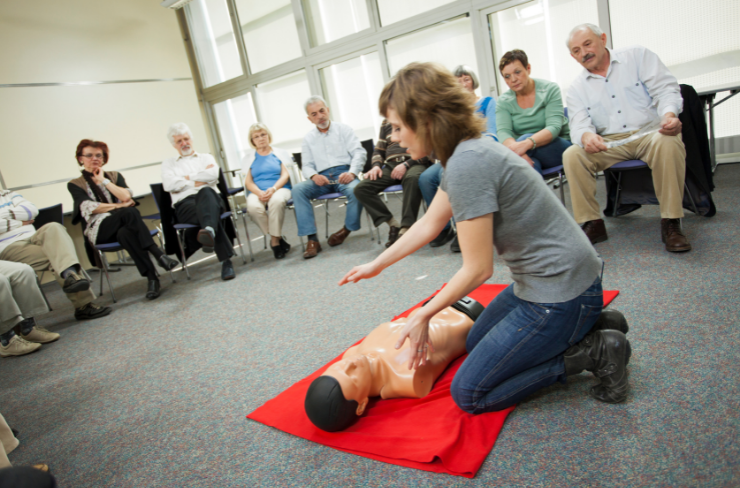HLTAID002/HLTAID010
Basic Life Support
- Basic Life Support
- Supersedes HLTAID002

Nationally
Recognised
Self-paced online theory with short in class practical assessment
Certificate within
24 hrs*
For our refund and cancellation policy, please click here.
*Certificates can only be issued on the same day when all course requirements have been successfully met.

Course Information
HLTAID009 Provide Cardiopulmonary Resuscitation (CPR) is included in HLTAID010.
HLTAID009 Provide Cardiopulmonary Resuscitation (CPR) must be completed annually for your Level 1 First Aid to remain valid until the 3-year accreditation has expired.
HLTAID010 has superseded HLTAID002.
Delivered in partnership with Allens Training Pty Ltd RTO 90909
Participants who have completed the Childcare First Aid course and have been assessed as competent in all assessments will receive a digital Statement of Attainment in:
- HLTAID012 Provide First Aid in an Education and Care Setting
- HLTAID011 Provide First Aid
- HLTAID010 Provide Basic Emergency Life Support
- HLTAID009 Provide Cardiopulmonary Resuscitation
Within 24 hours of completing their course.
There are no pre-requisites for the Childcare First Aid course. Participants are however required to have a minimum level of Literacy and Numeracy to be allowed admittance to this course.
Please notify us if you have any medical conditions or special needs that may prevent you completing all practical assessments.
This includes performing CPR on the floor on a mannequin. It is a requirement that CPR be performed for at least 2 minutes of uninterrupted single rescuer CPR on an adult resuscitation manikin placed on the floor.
The duration of the CPR Course is approximately 60-90 minutes online study with 30 minutes practical in class.
Performance Evidence
There must be evidence that the candidate has completed the following tasks in line with State/Territory regulations, first aid codes of practice, first aid guidelines determined by the Australian Resuscitation Council (ARC) and other Australian national peak clinical bodies and workplace or site procedures:
- Managed, in line with ARC guidelines, the unconscious, breathing casualty including appropriate positioning to reduce the risk of airway compromise
Managed, in line with ARC guidelines, the unconscious, non-breathing adult, including:
- Performing at least 2 minutes of uninterrupted single rescuer cardiopulmonary resuscitation (CPR) (5 cycles of both compressions and ventilations) on an adult resuscitation manikin placed on the floor
- Following the prompts of an automated external defibrillator (AED) to deliver at least one shock
- Demonstrating a rotation of single rescuer operators with minimal interruptions to compressions
- Responding appropriately in the event of regurgitation or vomiting
- Handing over to emergency services
- Providing an accurate verbal report of the incident
- Reviewing the incident
Managed, in line with ARC guidelines, the unconscious, non-breathing infant, including:
- Performing at least 2 minutes of uninterrupted single rescuer CPR (5 cycles both compressions and ventilations) on an infant resuscitation manikin placed on a firm surface.
Managed casualties, with the following:
- Anaphylaxis
- Asthma
- Non-life-threatening bleeding
- Choking
- Shock
Responded to at least one simulated first aid incident contextualised to the candidate’s workplace or community setting, where the candidate has no knowledge of the casualty’s condition prior to starting treatment, including:
- Identifying the casualty’s illness or injury through history, signs and symptoms
- Using personal protective equipment (PPE)
- Providing appropriate first aid treatment
- Conveying incident details to emergency services or advising casualty on any required post incident action
- Providing an accurate verbal report of the incident
- Reviewing the incident.
Knowledge Evidence (Online Pre-Course Theory & Practical Training)
Demonstrated knowledge required to complete the tasks outlined in elements and performance criteria of this unit:
Guidelines and procedures including:
- ARC guidelines relevant to the provision of first aid
- First aid guidelines from Australian national peak clinical bodies
- Potential incident hazards and risk minimisation processes when providing first aid
- Infection control procedures, including use of standard precautions and resuscitation barrier devices
- Requirements for currency of skill and knowledge
- First aid codes of practice
- Appropriate workplace or site procedures relevant to the provision of first aid
- Contents of first aid kits
Legal, workplace and community considerations, including:
- Duty of care requirements
- Own skills and limitations
- Consent and how it relates to the conscious and unconscious casualty
- Privacy and confidentiality requirements
- Awareness of potential need for stress management techniques and available support for rescuers
Considerations when providing CPR, including:
- Upper airway and effect of positional change
- Appropriate duration and cessation of CPR
- Appropriate use of an AED
- Safety and maintenance procedures for an AED
- Chain of survival
- How to access emergency services
Techniques for providing CPR to adults, children and infants including:
- How to recognise that a casualty is unconscious and not breathing normally
- Rate, ratio and depth of compressions and ventilations
- Correct hand positioning for compressions
- Basic anatomy, physiology and the differences between adults, children and infants relating to CPR
Signs, symptoms and management of the following conditions or injuries:
- Allergic reaction
- Anaphylaxis
- Asthma
- Non-life-threatening and life-threatening bleeding
- Cardiac conditions, including chest pain
- Choking
- Shock
- Stroke
